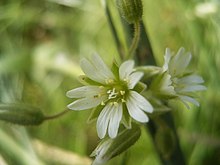Cerastium fontanum, also called mouse-ear chickweed, common mouse-ear, or starweed, is a species of mat-forming perennial or, rarely, annual plant. It is native to Europe but introduced elsewhere. Its identifying characteristics are tear-shaped leaves growing opposite one another in a star pattern, hairy leaves, and small white flowers. Mouse-ear chickweed typically grows to 4"-8" tall and spreads horizontally along the ground via the formation of roots wherever the stem falls over and contacts the ground.[1][2]
| Mouse-ear chickweed | |
|---|---|

| |
| Scientific classification | |
| Kingdom: | Plantae |
| Clade: | Tracheophytes |
| Clade: | Angiosperms |
| Clade: | Eudicots |
| Order: | Caryophyllales |
| Family: | Caryophyllaceae |
| Genus: | Cerastium |
| Species: | C. fontanum
|
| Binomial name | |
| Cerastium fontanum | |
Description
editCerastium fontanum is a low growing plant covered with small hairs which are not sticky, that is, without glandular tips. The erect flowering stems up to 45 cm (18 in) long and leaves, opposite, up to 20 mm (0.79 in) long without stalks. It has prostrate branches which do not bear flowers. The petals are shorter than the sepals or a little longer and are deeply divided. The flowers have 10 stamens with 5 styles.[3][4]
Habitat
editIt is common in grassland and along roadsides.[3]
Distribution
editIt is native to Europe, Greenland, the Himalayas and Japan.[5] It is common throughout Great Britain[3] and Ireland.[6] It has been introduced to the Falkland Islands and MacQuarie Island,[5] and to many other places around the world, including all 50 of the United States and all provinces and territories of Canada except Nunavut. [7]
Etymology
editCerastium is derived from the Greek word for 'horned', in reference to the shape of its fruit capsule.[8]
Fontanum means 'of fountains', 'of springs', or 'of fast-running streams'. It is a cognate with 'fountain' and 'font'.[8]
References
edit- ^ "Cerastium fontanum in Flora of North America @". Efloras.org. Retrieved 2022-05-01.
- ^ "USDA Plants Database".
- ^ a b c Clapham, A.R., Tutin, T.G. and Warburg, E.F. 1968. Excursion Flora of the British Isles. Cambridge University Press. ISBN 0-521-04656-4
- ^ Parnell, J and Curtis, T. 2012. Webb's An Irish Flora. Cork University Press ISBN 978-185918-4783
- ^ a b "Cerastium fontanum Baumg". Plants of the World Online. Royal Botanic Garden, Kew. Retrieved 16 April 2023.
- ^ Scannell and Synnott, D. 1972. Census Catalogue of the Flora of Ireland. Dublin
- ^ "USDA Plants Database".
- ^ a b Gledhill, David (2008). "The Names of Plants". Cambridge University Press. ISBN 9780521866453 (hardback), ISBN 9780521685535 (paperback). pp 99, 169